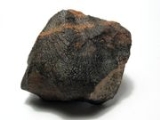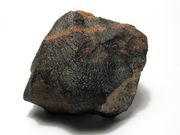
Achondrite
Encyclopedia

Meteorite
A meteorite is a natural object originating in outer space that survives impact with the Earth's surface. Meteorites can be big or small. Most meteorites derive from small astronomical objects called meteoroids, but they are also sometimes produced by impacts of asteroids...
that does not contain chondrule
Chondrule
Chondrules are round grains found in chondrites. Chondrules form as molten or partially molten droplets in space before being accreted to their parent asteroids...
s. It consists of material similar to terrestrial basalt
Basalt
Basalt is a common extrusive volcanic rock. It is usually grey to black and fine-grained due to rapid cooling of lava at the surface of a planet. It may be porphyritic containing larger crystals in a fine matrix, or vesicular, or frothy scoria. Unweathered basalt is black or grey...
s or plutonic rocks and has been differentiated and reprocessed to a lesser or greater degree due to melting and recrystallization on or within meteorite parent bodies. As a result, achondrites have distinct textures and mineralogies indicative of igneous processes.
Achondrites account for about 8% of meteorites overall, and the majority (about two thirds) of them are HED meteorite
HED meteorite
HED meteorites are a subgroup of achondrite meteorites. HED stands for "Howardite–Eucrite–Diogenite".These achondrites came from a differentiated parent body and experienced extensive igneous processing not much different from the magmatic rocks found on Earth and for this reason they closely...
s, originating from the crust of asteroid 4 Vesta
4 Vesta
Vesta, formally designated 4 Vesta, is one of the largest asteroids, with a mean diameter of about . It was discovered by Heinrich Wilhelm Olbers on March 29, 1807, and is named after the Roman virgin goddess of home and hearth, Vesta....
. Other types include Martian, Lunar
Lunar meteorite
A Lunar meteorite is a meteorite that is known to have originated on the Moon.-Discovery:In January 1982, John Schutt, leading an expedition in Antarctica for the ANSMET program, found a meteorite that he recognized to be unusual...
, and several types thought to originate from as-yet unidentified asteroid
Asteroid
Asteroids are a class of small Solar System bodies in orbit around the Sun. They have also been called planetoids, especially the larger ones...
s other than Vesta. These groups have been determined on the basis of e.g. the Fe
Iron
Iron is a chemical element with the symbol Fe and atomic number 26. It is a metal in the first transition series. It is the most common element forming the planet Earth as a whole, forming much of Earth's outer and inner core. It is the fourth most common element in the Earth's crust...
/Mn
Manganese
Manganese is a chemical element, designated by the symbol Mn. It has the atomic number 25. It is found as a free element in nature , and in many minerals...
chemical ratio and the 17O/18O oxygen
Oxygen
Oxygen is the element with atomic number 8 and represented by the symbol O. Its name derives from the Greek roots ὀξύς and -γενής , because at the time of naming, it was mistakenly thought that all acids required oxygen in their composition...
isotope
Isotope
Isotopes are variants of atoms of a particular chemical element, which have differing numbers of neutrons. Atoms of a particular element by definition must contain the same number of protons but may have a distinct number of neutrons which differs from atom to atom, without changing the designation...
ratios, thought to be characteristic "fingerprints" for each parent body.
Classification
Achondrites are classified into the following groups:- Primitive achondrites
- Asteroidal achondrites
- Lunar meteoriteLunar meteoriteA Lunar meteorite is a meteorite that is known to have originated on the Moon.-Discovery:In January 1982, John Schutt, leading an expedition in Antarctica for the ANSMET program, found a meteorite that he recognized to be unusual...
s - Mars meteoriteMars meteoriteA martian meteorite is a rock that formed on the planet Mars, was ejected from Mars by the impact of an asteroid or comet, and landed on the Earth. Of over 53000 meteorites that have been found on Earth, 99 are martian...
s
Primitive achondrites
Primitive achondrites, also called PAC group, are called in this way because their chemical composition is primitive in the sense that it is similar to the composition of chondrites, but their texture is igneous, indicative of melting processes. To this group belong:- Acapulcoites (after the meteorite Acapulco, Mexico)
- Lodranites (after the meteorite Lodran)
- Winonaites (after the meteorite Winona)
Asteroidal achondrites
Asteroidal achondrites, also called evolved achondrites, are called in this way because have been differentiated on a parent body. This means that their mineralogical and chemical composition was changed by melting and crytallization processes. They are divided several groups:- HED meteoriteHED meteoriteHED meteorites are a subgroup of achondrite meteorites. HED stands for "Howardite–Eucrite–Diogenite".These achondrites came from a differentiated parent body and experienced extensive igneous processing not much different from the magmatic rocks found on Earth and for this reason they closely...
s (Vesta). They originated most probably on the asteroid 4 Vesta, because their reflection spectra are very similar. They are named after the initial letters of the three subgroups:- HowarditeHowarditeHowardites are achondritic stony meteorites that originate from the surface of the asteroid 4 Vesta, and as such are part of the HED meteorite group. There are about 200 distinct members known.-Characteristics:...
s - EucriteEucriteEucrites are achondritic stony meteorites, many of which originate from the surface of the asteroid 4 Vesta and as such are part of the HED meteorite group. They are the most common achondrite group with well over 100 distinct finds at present....
s - DiogeniteDiogeniteDiogenites are a subgroup of the HED meteorite group, a type of achondritic stony meteorites.-Origin and composition:Diogenites originates from deep within the crust of the asteroid 4 Vesta, and as such are part of the HED meteorite group...
s
- Howardite
- AngriteAngriteAngrite is a rare achondrite consisting mostly of the mineral augite with some olivine, anorthite and troilite. It is named for the Angra dos Reis meteorite. Angrites are basaltic rocks, often having porosity, with vesicle diameters of up to 2.5 cm. Angrites are the oldest igneous rocks, with...
s - AubriteAubriteAubrites are meteorites named for Aubres, a small achondrite meteorite that fell near Nyons, France, in 1836. They are primarily composed of the orthopyroxene enstatite, and are often called enstatite achondrites...
s - UreiliteUreiliteUreilite is a rare type of stony meteorite that has a unique mineralogical composition very different from that of other stony meteorites. This dark grey or brownish meteorite type is named after the village Novy Urey , Mordovia Republic of Russia, where a meteorite of this type fell on 4 September...
s (after the meteorite Novy Ureii, Russia) - Brachinites (after the meteorite Brachina)
Lunar meteorites
Lunar meteorites, also called Lunanites, are meteorites that originated from the MoonMoon
The Moon is Earth's only known natural satellite,There are a number of near-Earth asteroids including 3753 Cruithne that are co-orbital with Earth: their orbits bring them close to Earth for periods of time but then alter in the long term . These are quasi-satellites and not true moons. For more...
.
Martian meteorite
Martian meteorites are meteorites that originated from MarsMars
Mars is the fourth planet from the Sun in the Solar System. The planet is named after the Roman god of war, Mars. It is often described as the "Red Planet", as the iron oxide prevalent on its surface gives it a reddish appearance...
. The are divided in four groups:
- Shergottites
- Nakhlites
- Chassignites
- OPX martian meteorites (ALH 84001)
External links
- Achondrite Images from Meteorites Australia

